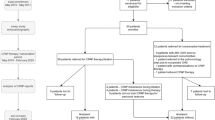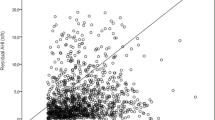Abstract
Purpose
The aim of this study was to investigate the time course of body weight, daytime sleepiness, and functional cardiorespiratory parameters in patients with both chronic obstructive pulmonary disease (COPD) and obstructive sleep apnea syndrome (OSA), after institution of domiciliary nasal continuous positive airway pressure (nCPAP).
Methods
Twelve consecutive obese outpatients (mean age = 61 ± 11 years; four women) were evaluated before (baseline) and after 3, 12, and 24 months of nocturnal nCPAP (4 h per night).
Results
At baseline, all patients were hypercapnic and hypoxemic, suffering from night desaturation (T 90 is the percentage of total recording time (TRT) spent with SaO2 ≤ 90% = 38 ± 2%) and sleepy (Epworth sleepiness scale [ESS] = 16.58 ± 0.86). Three months after the implementation of nCPAP, daytime PaCO2 and PaO2 improved up to 45.1 ± 0.9 and 69.0 ± 1 mmHg, respectively; mean pulmonary artery pressure (MPAP) decreased from 24.7 ± 1.1 to 19.2 ± 04 mmHg. All other variables showed progressive improvements up to 12 months. At 3 and 12 months, mean body mass index was slightly decreased (to 31.6 ± 0.2 and 30.7 ± 0.1 kg/m2, respectively); daytime sleepiness, nocturnal O2 desaturation, and maximal inspiratory pressure were also improved and thereafter remained stable.
Conclusions
In conclusion, in our patients with both severe OSA and mild-to-moderate COPD, arterial blood gasses and MPAP improved and stabilized after 3 months of nCPAP therapy, with the greatest improvements being in ESS score, T 90, and maximal inspiratory force from 3 up to 12 months; these parameters remained stable over the following 12 months. Finally, our data support early treatment with nCPAP in such patients.

Similar content being viewed by others
Abbreviations
- AHI:
-
apnea–hypopnea index
- AECOPD:
-
acute exacerbations of COPD
- BMI (kg/m2):
-
body mass index
- COPD:
-
chronic obstructive pulmonary disease
- DE:
-
Doppler echocardiography
- ESS:
-
Epworth sleepiness scale
- FEV1%:
-
forced expiratory volume in 1 s
- FVC%:
-
forced vital capacity
- FRC%:
-
functional residual capacity
- MPAP (mmHg):
-
mean pulmonary artery pressure
- MSaO2%:
-
mean nocturnal SaO2
- Pimax :
-
maximal inspiratory pressure
- nCPAP:
-
nasal continuous positive airway pressure
- NPPV:
-
noninvasive positive pressure ventilation
- NIV:
-
noninvasive mechanical ventilation
- NSaO2%:
-
nadir nocturnal SaO2
- OSA:
-
obstructive sleep apnea syndrome
- OSA + COPD:
-
overlap syndrome
- PaCO2 (mmHg):
-
arterial carbon dioxide tension
- PaO2 (mmHg):
-
arterial oxygen partial pressure
- RHC:
-
right heart catheterization
- SaO2%:
-
arterial oxygen saturation
- TRT%:
-
total recording time
- T90%:
-
percentage of TRT spent with SaO2 ≤90%
References
Weitzenblum E, Chaouat A, Kessler R, Canuet M (2008) Overlap syndrome: obstructive sleep apnea in patients with chronic obstructive pulmonary disease. Proc Am Thorac Soc 5(2):237–241
Weitzenblum E, Chaouat A (2004) Sleep and chronic obstructive pulmonary disease. Sleep Med Rev 4:281–294
Coughlin S, Calverley P, Wilding J (2001) Sleep disordered breathing—a new component of syndrome x? Obes Rev 2:267–274
Fletcher EC (1990) Chronic lung disease in the sleep apnea syndrome. Lung 168(Suppl):751–761
Alam I, Lewis K, Stephens JW, Baxter JN (2007) Obesity, metabolic syndrome and sleep apnoea: all pro-inflammatory states. Obes Rev 8:119–127
Sullivan CE, Berthon-Jones M, Issa FG (1983) Nocturnal nasal airway pressure for sleep apnea. N Engl J Med 309:112 (letter)
Doherty LS, Kiely JL, Swan V et al (2005) Long-term effects of nasal continuous positive airway pressure therapy on cardiovascular outcomes in sleep apnea syndrome. Chest 127:2076–2084
Pauwels RA, Rabe KF (2004) Burden and clinical features of chronic obstructive pulmonary disease (COPD). Lancet 364:613–620
Wijkstra PJ, Lacasse Y, Guyatt GH, Casanova C, Gay PC, Meecham Jones J, Goldstein RS (2003) A meta-analysis of nocturnal noninvasive positive pressure ventilation in patients with stable COPD. Chest 124(1):337–343
Krachman SL, Quaranta AJ, Berger TJ, Criner GJ (1997) Effects of noninvasive positive pressure ventilation on gas exchange and sleep in COPD patients. Chest 112:623–628
Petrof BJ, Kimoff RJ, Cosio LRD, MC GSB (1991) Nasal continuous positive airway pressure facilitates respiratory muscle function during sleep in severe COPD. Am Rev Respir Dis 143:928–935
Mansfield D, Naughton MT (1999) Effects of continuous positive airway pressure on lung function in patients with chronic obstructive pulmonary disease and sleep disordered breathing. Respirology 4(4):365–370
Rabe KF, Hurd S, Anzueto A, Barnes PJ, Buist SA, Calverley P, Fukuchi Y, Jenkins C, Rodriguez-Roisin R, van Weel C, Zielinski J, Global Initiative for Chronic Obstructive Lung Disease (2007) Global strategy for the diagnosis, management, and prevention of chronic obstructive pulmonary disease: GOLD executive summary. Am J Respir Crit Care Med 176(6):532–555
Abramson SV, Burke JB, Pauletto FJ, Kelly JJ Jr (1995) Use of multiple views in the echocardiographic assessment of pulmonary artery systolic pressure. J Am Soc Echocardiogr 8(1):55–60
Anonymous (1999) Sleep-related breathing disorders in adults: recommendations for syndrome definition and measurement techniques in clinical research. The report of an American Academy of Sleep Medicine Task Force. Sleep 22(5):667–689
Levi-Valensi P, Weitzenblum E, Rida Z, Aubry P, Braghiroli A, Donner C, Aprill M, Zielinski J, Wurtemberger G (1992) Sleep-related oxygen desaturation and daytime pulmonary haemodynamics in COPD patients. Eur Respir J 5:301–307
Black LF, Hyatt RE (1969) Maximal respiratory pressures: normal values and relationship to age and sex. Am Rev Respir Dis 99:696–702
Johns MW (1991) A new method for measuring daytime sleepiness: the Epworth sleepiness scale. Sleep 14:540–545
Teschler H, Berthon-Jones M, Thompson AB, Henkel A, Henry J, Konietzko N (1996) Automated continuous positive airway pressure titration for obstructive sleep apnea syndrome. Am J Respir Crit Care Med 154:734–740
Reeves-Hoche MK, Meck R, Zwillich CW (1994) Nasal CPAP: an objective evaluation of patient's compliance. Am J Respir Crit Care Med 149:149–154
Madison JM, Irwin RS (1998) Chronic obstructive pulmonary disease. Lancet 352:467–473
Celli BR, MacNee W, committee members (2004) Standards for the diagnosis and treatment of patients with COPD: a summary of the ATS/ERS position paper. Eur Respir J 23:932–946
Fisher MR, Criner GJ, Fishman AP, Hassoun PM, Minai OA, Scharf SM, Fessler AH, NETT Research Group (2007) Estimating pulmonary artery pressures by echocardiography in patients with emphysema. Eur Respir J 30:914–921
Kushida CA, Littner MR, Hirshkowitz M et al (2006) Practice parameters for the use of continuous and bilevel positive airway pressure devices to treat adult patients with sleep-related breathing disorders. Sleep 29:375–380
Stephen B, Dalal P, Berger M, Schweitzer P, Hecht S (1999) Noninvasive estimation of pulmonary artery diastolic pressure in patients with tricuspid regurgitation by Doppler echocardiography. Chest 116:73–77
Nishimura Y, Tsutsumi M, Nakata H, Tsunenari T, Maeda H, Yokoyama M (1995) Relationship between respiratory muscle strength and lean body mass in men with COPD. Chest 107:1232–1236
Brochard L, Isabey D, Piquet J, Amaro P, Mancebo J, Messadi AA, Brun-Buisson C, Rauss A, Lemaire F, Harf A (1990) Reversal of acute exacerbations of chronic obstructive lung disease by inspiratory assistance with a face mask. N Engl J Med 323:1523–1530
Robert D, Argaud L (2007) Clinical review: long-term non-invasive ventilation. Crit Care 11:210
de Miguel J, Cabello J, Sanchez-Alarcos JM et al (2002) Long term effects of treatment with nasal continuous positive airway pressure on lung function in patients with overlap syndrome. Sleep Breath 6:3–10
Mansfield D, Naughton MT (1999) Effects of continuous positive airway pressure on lung function in patients with chronic obstructive pulmonary disease and sleep disordered breathing. Respirology 4:365–370
Peker Y, Hedner J, Johansson A, Bende M (1997) Reduced hospitalization with cardiovascular and pulmonary disease in OSA patients on nasal CPAP treatment. Sleep 20:645–653
Young IH, Milhalyka M, Costas L, Sullivan CE (1987) Long term lung function changes in patients with obstructive sleep apnoea during treatment with nasal continuous positive airway pressure. Thorax 42:722
Sampol G, Sagalés MT, Roca A, de la Calzada MD, Bofill JM, Morell F (1996) Nasal continuous positive airway pressure with supplemental oxygen in coexistent sleep apnoea–hypopnoea syndrome and severe chronic obstructive pulmonary disease. Eur Respir J 9:111–116
Sforza E, Krieger J, Weitzenblum E, Aprill M, Lampert E, Ratamaharo J (1990) Long-term effects of treatment with nasal continuous positive airway pressure on daytime lung function and pulmonary haemodynamics in patients with obstructive sleep apnea. Am Rev Respir Dis 141:866–870
Resta O, Guido P, Picca V, Sabato R, Rizzi M, Scarpelli F, Sergi M (1998) Prescription of nCPAP and nBiPAP in obstructive sleep apnoea syndrome: Italian experience in 105 subjects. A prospective two centre study. Respir Med 92:820–827
Schafer H, Ewig S, Hasper E, Luderitz B (1998) Failure of CPAP therapy in obstructive sleep apnoea syndrome: predictive factors and treatment with bi-level-positive airway pressure. Respir Med 92:208–215
Strumpf DA, Millman RP, Carlisle CC, Grattan LM, Ryan SM, Erickson AD, Hill NS (1991) Nocturnal positive-pressure ventilation via nasal mask in patients with severe chronic obstructive pulmonary disease. Am Rev Respir Dis 144:1234–1239
Gay PC, Hubmayr RD, Stroetz RW (1996) Efficacy of nocturnal nasal ventilation in stable, severe chronic obstructive pulmonary disease during a 3-month controlled trial. Mayo Clin Proc 71:533–542
Lüthje L, Andreas S (2008) Obstructive sleep apnea and coronary artery disease. Sleep Med Rev 12:19–31
Tasali E, Mokhlesi B, Van Cauter E (2008) Obstructive sleep apnea and type 2 diabetes: interacting epidemics. Chest 133:496–506
Author information
Authors and Affiliations
Corresponding author
Rights and permissions
About this article
Cite this article
Toraldo, D.M., De Nuccio, F. & Nicolardi, G. Fixed-pressure nCPAP in patients with obstructive sleep apnea (OSA) syndrome and chronic obstructive pulmonary disease (COPD): a 24-month follow-up study. Sleep Breath 14, 115–123 (2010). https://doi.org/10.1007/s11325-009-0291-1
Received:
Accepted:
Published:
Issue Date:
DOI: https://doi.org/10.1007/s11325-009-0291-1




